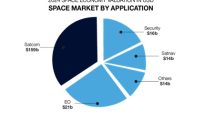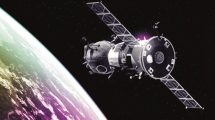 EIAST celebrated the fifth anniversary of DubaiSat-1, the first remote sensing satellite owned by the UAE, launched in 2009 on board a Dnepr rocket through the Baikonur base in Kazakhstan.
EIAST celebrated the fifth anniversary of DubaiSat-1, the first remote sensing satellite owned by the UAE, launched in 2009 on board a Dnepr rocket through the Baikonur base in Kazakhstan.
The satellite still operates with high precision and its systems still work accurately, efficiently and regularly.
H.E. Yousuf Hamad Al Shaibani, Director General of EIAST, expressed his pride at the launch of DubaiSat-1 five years ago and its accurate and regular operation since then. He said: “It is a true testament to the success of the institution’s strategy built upon the transfer of modern knowledge and advanced technology to empower human resources to manufacture and operate satellites.”
According to Al Shaibani, the DubaiSat-1 project was a challenge for the institution as it was its first. However, the UAE has proven its progress and advancement in the field of space science to strengthen its position as a global leader in the field. “Our aim is to achieve goals that promote the UAE social and economic development through the exploitation of space science technologies and the development of our human capital, in line with UAE Vision 2021 and the knowledge-based economy,” he said.
“We truly appreciate the efforts and the continuous support of our leaders who have played a major role in the achievement of advanced successes and in taking the UAE to a new level of leadership and excellence in the space industry,” he added.
Since its launch in 2009, DubaiSat-1 made a number of significant achievements. The greatest one was the capture of pictures for the Emirates Atlas which includes satellite pictures of different areas and emirates in the country. The atlas is available on the website of EIAST and can benefit school and university students alike, free of charge.
In the past five years, EIAST provided government entities and authorities with satellite pictures and data that were helpful in many strategic initiatives and development projects in the country. Furthermore, through DubaiSat-1, EIAST contributed to the support of assistance and disaster relief missions during the floods in Pakistan in 2010 and the Japanese Tsunami in 2011.
DubaiSat-1 is the first phase of the triple integrated approach adopted by EIAST and based upon the transfer of knowledge and advanced technology with its strategic partner, Satrec Initiative, the leading solution provider of Earth Observation Missions. The partnership played a significant role in developing the skills and expertise of the team of Emirati engineers and launching DubaiSat-1 into space following two years of hard work.
“After five years of its launch, DubaiSat-1 remains an achievement the institution can be proud of. It is the successful result of the efforts of the team who has contributed to 30% of its manufacture process”, said Eng. Salem Humaid Al Marri, Assistant Director General for Scientific and Technical Affairs at EIAST.
“Any satellite such as DubaiSat-1 would last up to 5 to 7 years. The regular work and readiness of all the satellite systems and devices are a testament to the good planning, the expertise, and the competence of EIAST”, he added. “The reason is the good design and the tests the satellite underwent while it was being manufactured, to enhance its ability to adapt to any climate changes in space such as temperature and solar radiation, along with the daily follow-up by engineers at the ground station”, he concluded.












Add Comment